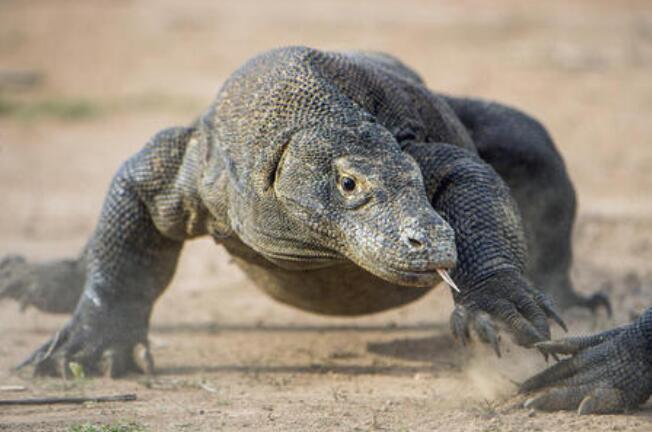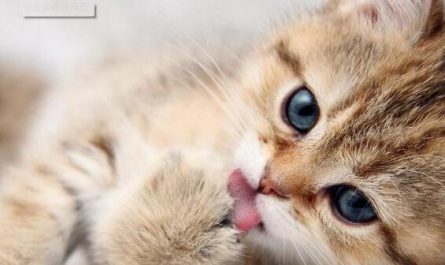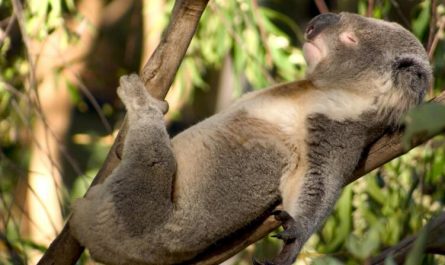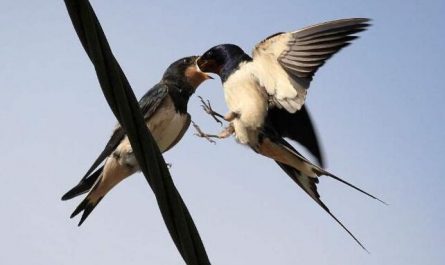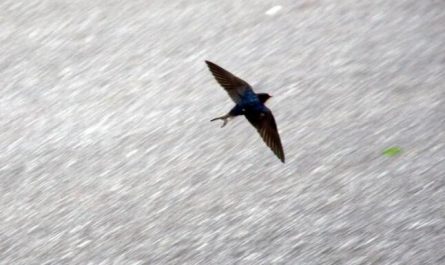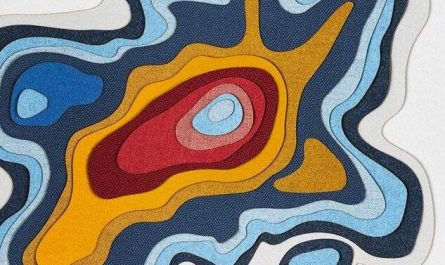The largest lizard in the world-the Komodo dragon
There is an archipelago in Indonesia called Nusa Tenggara, Comodo is part of the archipelago. Comodo Island is 4 to 5 kilometers long and 10 to 13 kilometers wide. Here, the largest lizard in the world lives, and the inhabitants of the island call it the “Dragon of Comodo”.
Comodo Island has a mild climate, dense jungles, surrounded by the sea, and beaches and forested reefs along the coast. Such a natural environment has become the “paradise” for the life of the Komodo dragon.
Adult giant lizards are generally about 3.5 to 5 meters in length (large females, small males) and weigh 100-150 kg. The skin is rough, with many raised bumps, no scales, dark brown, and the mouth is full of huge and sharp teeth (the world’s 26 species of giant lizards, only it has teeth). However, it is basically “dumb” and its vocal cords are very underdeveloped; even when it is irritated, it can only be heard making a “hiss, hiss” sound. When it preys on animals, it is extremely ferocious and runs extremely fast. The huge and powerful long tail and pointed claws are great tools for preying. It feeds on wild boar, deer, and monkeys on the island. As long as an adult monitor lizard sweeps its tail, it can sweep down a pony under three years old, then bite off the horse’s leg and drag the horse to the bush to eat it. When it can’t finish eating, it will bury the rest in sand or grass and eat it when it’s hungry. The wild deer, wild boars, goats and various monkeys living on the island of Comodo fled when they saw the monitor lizard. After the lizards are full, they lie down in the jungle, on the beach or on the reef, sleep sweetly and bask in the sun. It is good at swimming and has a special instinct to dive into the water to fish and eat or stay underwater for dozens of minutes.
Comodo dragon lizards are sexually mature at 3 to 5 years old. They come into estrus in July and copulate each year. They start to lay eggs in August. A newly mature female lizard can only lay 4-6 eggs at a time. Give birth every two or three days. At about 10 years old, it enters the peak period of spawning, each time more than 20 eggs are laid, and the eggs are buried in the sand nest, and the eggs are incubated at the temperature of solar radiation. After 8 months, the young lizards break their shells. When they first came out of their shells, the small lizards were the size of our domestic goose.
There are about 500 to 700 monitor lizards on the island of Comodo. It is currently a rare animal in the world. The Indonesian government strictly protects it and strictly prohibits hunting.
The living habits of the Komodo dragon
living environment
Adult Komodo dragons mainly live in savanna forests. They prefer open areas with weeds and shrubs, but some people have found monitor lizards in other places, such as beaches, mountain tops, and dry river beds.
activity
Komodo dragons set their homes in holes in rocks or under trees. Every morning when the sun rises, they leave their homes to bask on the rocks, warm their stiff bodies, and then begin to search for food. After eating, the monitor lizard lays down in the jungle, on the beach or on the reef, sleeping and basking in the sun. It is good at swimming, has the special ability to dive into the water to fish and eat or stay underwater for dozens of minutes, and even swim across the ocean.
Komodo dragons are very afraid of strong sunlight. The scorching sun at noon in the equatorial region makes the Komodo dragons have to rest in a cool place.
Because adult Komodo dragons will prey on cubs, young Komodo dragons will generally live in trees before they are eight months old, in order to have a greater chance of survival.
The Komodo dragon is basically “dumb” with very underdeveloped vocal cords; even when provoked, it can only hear its “hiss, hiss” sound. [4]
Eat
As a carnivorous monitor lizard, the monitor lizard feeds on wild boars, deer, monkeys, and snakes on the island, and sometimes preys on weaker species and larvae. They also occasionally attack humans or feed on human corpses. By 2010, about 12 people died from the venom in the bite of the monitor lizard.
The monitor lizard runs extremely fast and can instantly accelerate to 20-25 km/h, but the monitor lizard rarely hunts prey. The Komodo dragon has a keen sense of smell, and will hide in an ambush on the way its prey passes by. When the time is right, it will attack. When the prey is about 1 meter away (so far I don’t understand why the prey can’t see it when it’s 1 meter away from the monitor), it will pounce on it, first knock the prey to the ground with its sharp claws, and directly bite the prey. Legs, after the prey cannot move, use sharp teeth to tear open the throat or abdomen of the prey, and the prey is killed due to hemorrhage. At this moment, the monitor lizard uses jagged teeth and powerful claws to tear the prey into pieces and quickly swallow large chunks of meat. Scientists once witnessed a female monitor lizard weighing no more than 50 kilograms, eating a wild boar weighing 31 kilograms in 17 minutes. The monitor lizard’s stomach is like a rubber sac, which expands easily. Adult monitor lizards can eat up to 80% of their body weight in one meal, so the body weight of monitor lizards varies greatly before and after meals. Carrion is a favorite food of Komodo dragons.
In order to deal with huge prey, they developed their own biological weapons-the venom gland of the Komodo dragon. The venom gland secretes a kind of venom that can resist the clotting of blood. At this time, the komodo dragon will find it along the smell. The victims’ bodies feasted, their forked tongues are like radar antennas, distinguishing the smell of the breeze. The smallest breath in the air will be noticed by the monitor lizards, and they will get a hint that there is carrion seven or eight kilometers away.
Scientists have experimented with the deadly bacteria in the Komodo dragon’s mouth. Observing the head of a female Komodo dragon with modern medical machinery, it was found that the Komodo dragon had a venom gland. This card also became the same as that of a venomous snake. It uses venom to attack its prey instead of Deadly bacteria. However, the venom of the Komodo dragon remains to be studied.
The scent of the prey attracts monitor lizards hunting everywhere, and they come to share their prey. There are rules for dividing meals. In a group of Komodo dragons, the older and larger ones usually eat first. They will hit young people with their strong tails to prevent them from getting close to the food, followed by obedients or “friends and relatives”. Unfamiliar diners are usually arranged to eat last.
When the Komodo dragon can’t finish the prey, it will bury the rest in sand or grass, and eat it when hungry. The wild deer, wild boar, goats and various monkeys living on the island of Comodo fled when they saw the monitor lizard. A program described the Komodo dragon’s predation: “The lizard stared at its prey, and suddenly the lizard rushed up and bit the buffalo. After only a week, the buffalo was poisoned. Then the lizard began to eat the buffalo, and the lizard directly Biting off the buffalo’s leg, you can see how powerful the lizard is, but after a while the whole buffalo will be gnawed away, leaving only some bones.”
The way of living
The Komodo dragon is a species left over from the dinosaur era. Scientists have discovered that the Komodo dragon has an amazing food intake and prefers to prey on large animals such as water buffalo. The water buffalo is large in size and highly aggressive. It is almost impossible to win by force alone. The magic weapon for the Komodo dragon to win is the deadly venom and a large number of bacteria in its saliva. When the dragon lizard finds the buffalo, it slowly approaches, and then unexpectedly bites on the buffalo’s leg. The buffalo is frightened and fled, and the dragon is finished. The first step in preying on buffaloes. But the venom does not kill the buffalo immediately. Therefore, in order to enjoy the fruits of victory, the monitor lizard must track the buffalo by scent, and must be ahead of other carnivores. The monitor lizard’s crawling speed is far lower than that of the buffalo. The monitor lizard has to keep tracking the buffalo. After a few days, the monitor lizard is already hungry, but the buffalo can’t see any signs of weakness. Once the monitor starts to track the buffalo, it ignores the way. Monkeys, wild boars and other small animals, even if these small animals ran in front of the monitor lizard, it continued on its way as if it hadn’t seen them. The water buffalo is strong and strong, and it usually takes ten days and a half to wait for the body to undergo qualitative changes. When the bacteria and venom in the water buffalo break out, it is time for the monitor lizard to enjoy food. Regardless of speed or strength, the monitor lizard is not an opponent of the buffalo, and its venom can not kill the buffalo immediately, but once it determines the target, it will pursue it unswervingly until it succeeds. This may be the Komodo monitor. The reason for survival so far.
The status of the Komodo dragon population
Comodo Island is deserted all year round. Later, the Sultan of Sumbawa began to exile the criminals to the island to serve his sentence and found giant lizards, but no one believed it. In 1911, when an American pilot flew a small plane over the island of Como at low altitude, he accidentally found the “monster”. In 1915, the Indonesian government regarded this animal that cannot be found anywhere else on the earth as a national treasure and strictly protected it. In 1926, American Burden took a large number of shots about the natural scenery of the Komodo island and the monitor lizard. In 1931, the film “KINGKONG” was produced. The Komodo monitor became known to the world. In 1990, the Indonesian government established the Comodo National Park and officially opened it to tourists.
People have hunted and killed the Komodo dragon to get the hard and thick skin, or caught it to the zoo for exhibition. As a result, there are no more than 3,000 Komodo dragons left. It is one of the most precious animals in the world. It is a vulnerable species of the Indonesian National Animal Protection and Nature Conservation Union. They have been protected in the national park on Komodo Island. In 1991, Comodo National Park was registered as a World Heritage Site.
